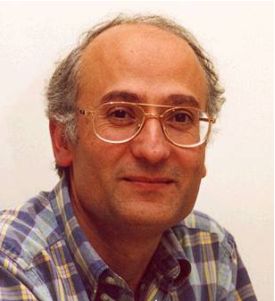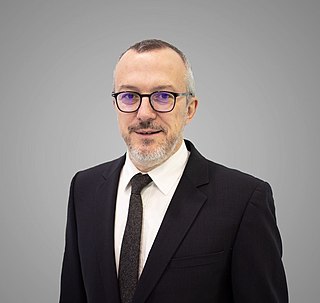External links
| Scholia has an author profile for Bernadette Charleux . |
Bernadette Charleux | |
|---|---|
| Nationality | French |
| Scientific career | |
| Fields | Polymer Chemistry |
| Institutions | |
| Doctoral advisor | Christian Pichot |
Bernadette Charleux is a French polymer chemist. She is a member of the Academia Europaea [1] and a senior member of the Institut universitaire de France since 2009. [2] Since 2012, she is the Deputy Vice-president of Research and Development at Saint-Gobain. [1]
Bernadette Charleux first worked on emulsion polymerization, which led to the creation of new materials : functional latexes, amphiphilic copolymers, etc. before turning to pioneering research on Reversible-deactivation radical polymerization in aqueous media. More recently, she has worked on the creation of nano-objects via the self-assembly of macromolecules. [3]
This work has led to numerous patents. [4]
| Scholia has an author profile for Bernadette Charleux . |
Jean M.J. Fréchet is a French-American chemist and Professor Emeritus at the University of California, Berkeley. He is the head of the Division of Materials Synthesis and Materials Science of the Lawrence Berkeley National Laboratory, Director of the Organic and Macromolecular Facility for the Molecular Foundry at the Lawrence Berkeley National Laboratory, and Vice-President for research at King Abdullah University of Science and Technology. He has authored nearly 900 scientific papers and holds over 70 United States patents. His research areas include organic synthesis and polymer chemistry applied to nanoscience and nanotechnology with emphasis on the design, fundamental understanding, synthesis, and applications of functional macromolecules.
Ludwik Leibler, born in 1952 is a Polish-born French physicist. He is Professor of École supérieure de physique et de chimie industrielles de la ville de Paris and member of the French Academy of Sciences and National Academy of Engineering.

Didier Astruc carried out his studies in chemistry in Rennes. After a Ph. D. with professor R. Dabard in organometallic chemistry, he did post-doctoral studies with professor R. R. Schrock at the Massachusetts Institute of Technology Cambridge, Massachusetts, in the U.S. and later a sabbatical year with professor K. P. C. Vollhardt at the University of California at Berkeley. He became a CNRS Director of research in Rennes, then in 1983 full Professor of Chemistry at the University Bordeaux 1. He is known for his work on “Electron-Reservoir” complexes and dendritic molecular batteries, catalytic processes using nanoreactors and molecular recognition using gold nanoparticles and metallodendrimers. He is the author of three books, scientific publications and the editor of five books or special issues. He has been a member of the National CNRS committee from 2000 to 2008 and the President of the Coordination Chemistry Division of the Société Française de Chimie from 2000 to 2004. Didier Astruc is on the Thompson-Reuters list of the top 100 chemists who have achieved the highest citation impact scores for their chemistry papers published between 2000 and 2010. and on the list of the Highest Cited Researchers 2015 and 2016 (Thomson-Reuters). and 2017
Charles Sadron, was a French physicist who specialized in the study of biological macromolecules.

Institut Charles Sadron is a research center of the Centre national de la recherche scientifique, associated with the University of Strasbourg, which was created in 1954 to answer the demand for fundamental research in the emerging field of polymer science.

Françoise Combes is a French astrophysicist at the Paris Observatory and a professor at the Collège de France where she has been the chair of Galaxies and cosmology since 2014.
Yves Bréchet is a physicist, specialist of materials science, former High Commissioner for Atomic Energy of France, current Scientific Director of Saint Gobain, professor (part-time) at Monash University, and a member of the French Academy of Sciences.

Poly(methacrylic acid) (PMAA) is a polymer made from methacrylic acid, which is a carboxylic acid. It is often available as its sodium salt, poly(methacrylic acid) sodium salt. The monomer is a viscous liquid with a pungent odour. The first polymeric form of methacrylic acid was described in 1880 by Engelhorn and Fittig. The use of high purity monomers is required for proper polymerization conditions and therefore it is necessary to remove any inhibitors by extraction or via distillation. To prevent inhibition by dissolved oxygen, monomers should be carefully degassed prior to the start of the polymerization.

Gérard Férey was a French chemist who was a member of the French Academy of Sciences and a professor at the Versailles Saint-Quentin-en-Yvelines University. He specialized in the physical chemistry of solids and materials. He focused on the crystal chemistry of inorganic fluorides and on porous solids.

Samir Zard is a Lebanese-French chemist and the president of the department of chemistry at the École polytechnique, Paris, where he also directs the department of organic chemistry and synthesis.
Paolo Samorì is an Italian physical chemist and Distinguished Professor (PRCE) and director of the Institut de Science et d'Ingénierie Supramoléculaires (ISIS) of the Université de Strasbourg (UNISTRA) & CNRS where he is also head of the Nanochemistry Laboratory.

Gero Decher is a German chemist and Distinguished Professor at the Faculty of Chemistry of University of Strasbourg. He is best known for his seminal role in the development of polyelectrolyte multilayers, which is today known as “layer-by-layer (LbL) assembly”, a simple yet powerful nanofabrication method that has enabled the development of entirely new technologies, such as biocompatible coatings on medical devices, ultrastrong nanocomposites, neural interfaces, charge-storage devices, gas separation, fire retardants, and gene delivery platforms. According to CNRS International Magazine, Decher's work has “sparked a small revolution in materials science”. Layer-by-layer assembly is now an established part of the nanobiotechnology curriculum.

Roger Guilard is a French chemist. He is a professor of chemistry at the University of Burgundy in Dijon, France where he is a member of the Institute of Molecular Chemistry of the University of Burgundy.

Patrice Simon is a French chemist in the field of materials science and electrochemistry. He is currently a Distinguished Professor at the Université Paul Sabatier since 2007. His research activities are focused onto the modification of the material/electrolyte interfaces in electrodes for electrochemical energy storage devices such as supercapacitors and batteries. He is also former Director of the European Research Institute "ALISTORE ERI", and currently deputy director of the French Newtwork on Electrochemical Energy Storage (RS2E).

The Strasbourg Institute of Material Physics and Chemistry is a joint research unit between the French National Center for Scientific Research (CNRS) and the University of Strasbourg. It was founded in 1987 and is located in the district of Cronenbourg in Strasbourg, France.

Marc Fontecave is a French chemist. An international specialist in bioinorganic chemistry, he currently teaches at the Collège de France in Paris, where he heads the Laboratory of Chemistry of Biological Processes.

Stéphane Mangin is a physicist, professor at University of Lorraine, Nancy, France. He is head of the Nanomagnetism and Spintronics team at Institut Jean Lamour, a joint laboratory between French National Centre for Scientific Research (CNRS) and University of Lorraine.

Cathérine Cécile Picart is a French biophysicist and bioengineer. She is the Head of the Department of Health at CEA Grenoble in the area of fundamental research, a professor at the Institut polytechnique de GrenobleÉcole nationale supérieure de physique, électronique, matériaux (PHELMA) and researcher at the Laboratoire des Matériaux et du Génie Physique (LMGP).

The French group for the study of polymers and their application, also called more simply French polymer group (GFP) is a French nonprofit organization and learned society, which aims to promote polymer chemistry, physics, and material science in French industry and institutes of higher learning.
Jeanne Crassous is a French chemist who is a Professor and Director of Research at the French National Centre for Scientific Research (CNRS). She leads the Marie Skłodowska-Curie Actions International Training Network HEL4CHIROLED.